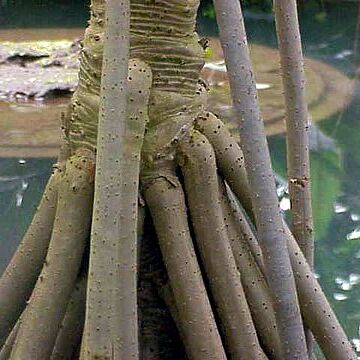Trees, shrubs, or woody lianas, terrestrial, evergreen, dioecious. Stems simple or often bifurcately branched, ringed with persistent annular leaf scars, often producing adventitious prop roots; aerial roots present or absent. Vegetative reproduction by suckers present or absent. Leaves simple, numerous, spirally arranged at apex of stems and branches, sessile, linear to lanceolate, leathery, often lustrous or glaucous, glabrous, keeled abaxially, parallel veined, with numerous horizontal secondary veins, base open-sheathed and amplexicaul, margin and midrib abaxially often spinulose, apex often long acuminate. Male inflorescences axillary and terminal, compound, bracteate, comprising several-branched racemes or panicles with crowded flowers on spicate ultimate branches; spathes often enlarged at apex, white or colored. Perianth absent. Male flowers sessile (pedicellate in Sararanga Hemsley), with pistillode sometimes present; stamens numerous, fasciculate, arising on rachises or spadix branches; filaments smooth (Pandanus) or papillose (Freycinetia), seemingly branched; anthers basifixed, 2-celled with 4 pollen sacs, dehiscing by longitudinal slits, connective often apiculate; pollen grains often spinulose. Female inflorescences terminal, solitary or in spikes, racemes, or capitula, short, bracteate, with crowded flowers, often pendulous in fruit. Female flowers with or without staminodes; pistils free or aggregated and appressed to adjacent pistils forming 1-to many-carpelled phalanges or clusters; ovary superior, 1-to several locular; ovules solitary to numerous, anatropous, placentation basal or parietal; style absent or very short; stigmas 1 or more, subsessile, glandular-papillose. Fruit a berry (Freycinetia) or drupe (Pandanus), when drupaceous a multiple structure (syncarp) composed of 2-20 woody, or basally fleshy or fibrous, cylindric to globose, connate, free or often crowded and clustered carpels, each cluster of carpels termed a "phalange," with mesocarp fibrous and often pithy or hollow above, fibrous and fleshy below; endocarp membranous or evanescent. Seeds 1 to numerous, minute, often fusiform; testa membranous (Pandanus) or crustose (Freycinetia); endosperm oily and fleshy, or starchy; strophiole originating from raphe sometimes present; embryo basal, minute; germination often epigeal.
Dioecious, very rarely monoecious, trees, shrubs or woody climbers, often with prop or aerial roots, glabrous; branching sympodial. Leaves spirally arranged, 3-ranked (in Australia), sessile, sometimes auriculate, usually linear, sometimes narrowly ovate, usually M-shaped in transverse section, usually armed with prickles on margins and abaxial midrib. Inflorescences usually terminal, usually pendent, spicate (in Australia), simple or branched, with leafy, sometimes coloured, basal bracts. Perianth absent (in Australia). Male flowers: stamens 1–many, densely packed on rachis either separately or on stemonophores which correspond to individual flowers; anthers basifixed, 2-celled. Female flowers: staminodes absent or minute; ovary with 1–many carpels, free or connate into syncarps; ovules 1–many; stigma sessile or shortly stalked. Fruit a closely packed head of berries, or a cylindrical to spherical head of individual drupes or polydrupes (phalanges). See also Stone (1993), Green (1994).
Flowers dioecious, paniculate or densely crowded into spadices, the latter axillary and terminal, fasciculate or paniculate, enclosed at first by spathaceous sometimes coloured or leafy bracts
Leaves in 4 rows or spirally arranged and crowded towards the top of the shoots, linear, sheathing at the base, keeled, mostly spinulose on the margins and keel
Ovary superior, 1-celled, free or confluent with adjacent ovaries into bundles with separate or united stigmas; style very short or absent
Male flower: stamens numerous; filaments free or connate; anthers erect, basifixed, 2-celled, the cells sometimes again once divided
Female flower: staminodes absent or small and hypogynous or adnate to the base of the ovary
Syncarps oblong to globose; mature carpels woody, drupaceous or baccate, pulpy inside
Trees or shrubs, trunk and branches often with aerial roots
Seeds minute, with fleshy endosperm and minute embryo
Ovules solitary to many, basal or parietal
Perianth rudimentary or absent

